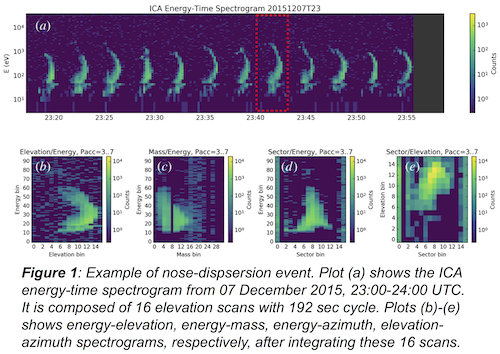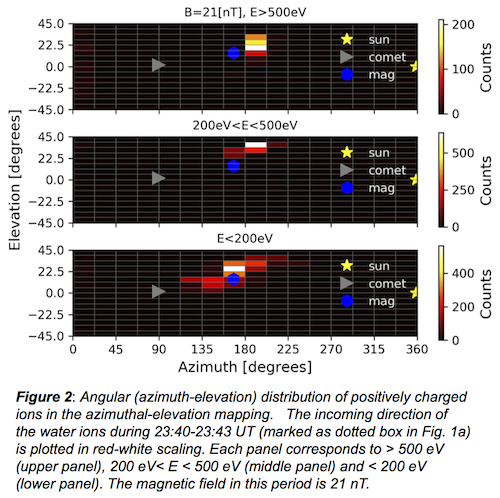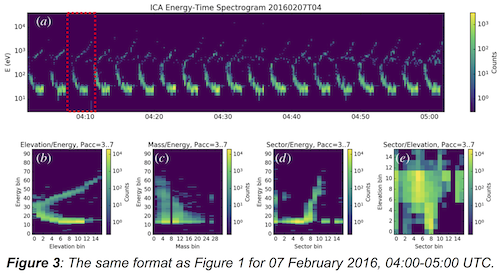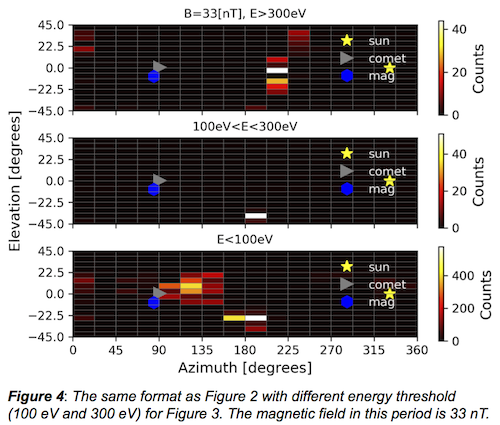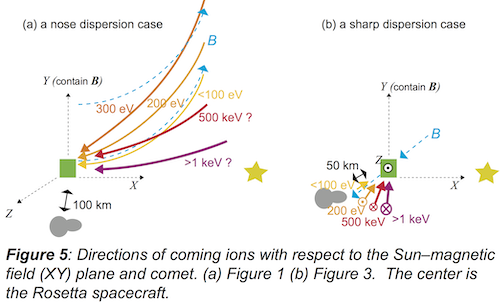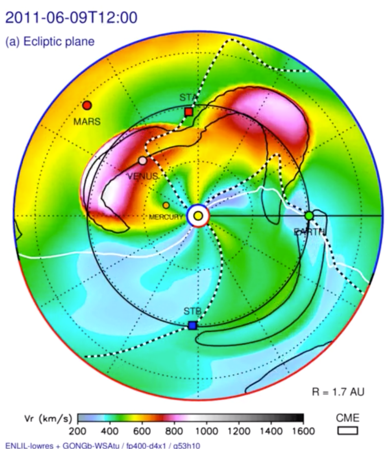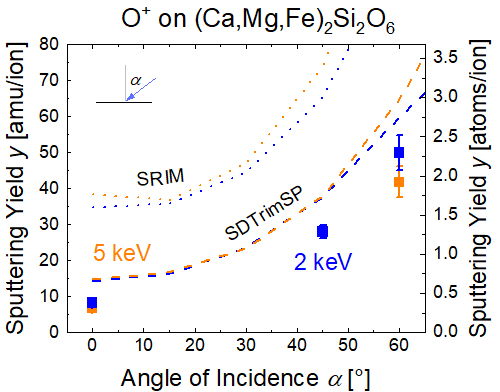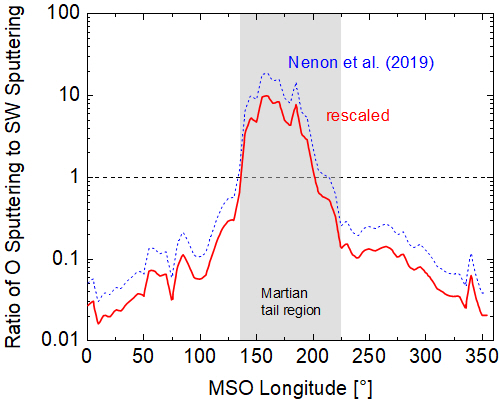Background
The ion temperature is a key parameter controlling the structure of planetary ionospheres. In the lower ionosphere, where ion motion is dominated by collisions with neutrals, ion temperatures directly affect collision frequencies. At higher altitudes, in the collisionless regime, ion temperatures influence whether some fraction of the distribution can overcome the planet’s gravity to escape to space. Reliable knowledge of ion temperatures is critical to understanding current ionospheric structures as well as the long-term evolution of planetary atmospheres.
For nearly 40 years, the only in-situ measurements of ion temperatures at Mars were obtained from ~375 km to ~120 km altitude during the descents of the Viking landers in 1976 [1]. These measurements were made by retarding potential analyzers. Assumptions about ion composition were required to derive temperatures, and all ion species were assumed to be the same temperature. While this assumption is reasonable in the collisional regime below the exobase (~200 km), mass-dependent electromagnetic acceleration can cause temperatures to diverge at higher altitudes.
Until recently, ion temperatures at Mars have primarily been investigated using models. The majority of work has focused on explaining elevated electron temperatures in the upper ionosphere, concluding that a topside heat source (e.g. the solar wind) is required to achieve agreement between modeled profiles and Viking observations [2, 3]. The Combined Atmospheric Photochemistry and Ion Tracing (CAPIT) model reproduced Viking profiles by tracing ion paths while accounting for magnetic fields, major chemical reactions, and wave heating [4]. Models of the solar wind interaction with Mars (e.g. [5],[6]) have traditionally adopted a simplified lower boundary assuming equal electron and ion temperatures, which is significantly in error above ~200 km, in contrast to findings by Matta et al. [7] that different ion species have different temperatures. Recently, Ma et al. [8] showed that the electron pressure gradient significantly affects ion temperatures.
Since 2014, comprehensive measurements of the ionosphere above 120 km have been made by the Mars Atmosphere and Volatile EvolutioN (MAVEN) orbiter at all local times and most latitudes. Studies based on these data are beginning to revolutionize our understanding of the planet’s ionosphere. In this study, we use data collected by the MAVEN SupraThermal And Thermal Ion Composition (STATIC) instrument to present the first measurements of ion temperature at Mars since the Viking landers.
Methodology
We will present O2+ temperature profiles measured in the Martian ionosphere by STATIC. STATIC measures ion energies from 0.1 eV to 30 keV over a 360°x90° field of view, with mass resolution capable of distinguishing the main ionospheric and escaping species: CO2+, O2+, O+, and H+ [9]. Several instrumental effects contribute to the challenge of extracting ion temperatures from STATIC data, some of which require empirical corrections that are currently being calculated. Three different methods are used to calculate the O2+ temperature using different assumptions which are valid over different, overlapping altitude ranges. These calculations include corrections for spacecraft potential, ion suppression, and instrument response, as well as backscatter, straggling, and molecular fragmentation inside the instrument, among other effects. These calibrations have not been finalized, meaning that the O2+ temperatures presented require further correction.
Selection of the best temperature is based on characteristics of the measured distribution. If the population is beam-like (i.e. narrow in energy or angle), then the width of the beam indicates the temperature. However, if the distribution is broad, then calculating moments of the three-dimensional velocity distribution function provides a kinetic temperature, which can be higher than the thermal temperature of the Maxwellian core of the distribution. Once temperatures have been calculated, the data are processed automatically to determine which estimate is the most appropriate. The resulting temperature profiles are largely continuous from MAVEN’s periapsis near 150 km up to altitudes well above 350 km.
Results and Discussion
We present O2+ temperature profiles measured by STATIC when MAVEN’s periapsis occurred close to local noon, midnight, dawn, and dusk. These temperature profiles will be presented alongside the neutral Ar temperature measured by the Neutral Gas and Ion Mass Spectrometer, and the electron temperature measured by the Langmuir Probe and Waves experiment [10, 11]. We use profiles measured on the inbound segment of the orbit to minimize the effect of changing solar zenith angle. In addition, Ar temperatures are only available on the inbound segment. The Ar temperature is expected to be representative of the entire neutral population. At altitudes below ~250 km, the ion distribution is usually dominated by O2+, and we anticipate that all ions will converge to the O2+ temperature.
The ion, neutral, and electron temperatures are expected to converge below the exobase, where high collision rates force these populations to equilibrate. Although this thermalization begins to occur below ~200 km, temperature differences between Ar and O2+ persist down to MAVEN’s periapsis of 150 km. The electron temperature is several times higher than the ion temperature in this altitude range, contrary to the assumptions made in most modeling studies.
We note differences in profiles measured at different local times. Unsurprisingly, the median periapsis ion temperature at midnight is colder than at noon, reaching ~250 K at noon compared to ~175 K at midnight. Variations in temperature between successive orbits are larger on the nightside than the dayside, indicated by the larger range of temperatures measured on the nightside, which is to be expected due to the patchy, tenuous nature of the nightside ionosphere.
Measuring the cold thermal ion temperature at another planet poses many challenges. MAVEN STATIC is the first instrument capable of making such measurements at Mars–indeed, it is the first instrument capable of measuring the ion temperature since the Viking landers. Substantial progress has been made toward deriving ion temperatures from STATIC. Once the necessary calibrations are finalized, O2+ temperatures will be calculated for nearly the entire MAVEN mission, providing a new tool for systematically analyzing the Martian atmosphere.
References
[1] Hanson et al. https://doi.org/10.1029/JS082i028p04351
[2] Shinagawa & Cravens. https://doi.org/10.1029/JA094iA06p06506
[3] Cui et al. https://doi.org/10.1002/2014JE004726
[4] Andersson et al. https://doi.org/10.1016/j.icarus.2009.07.009
[5] Dong et al. https://doi.org/10.1002/2014GL059515
[6] Brecht & Ledvina. https://doi.org/10.1016/j.icarus.2009.04.028
[7] Matta et al. https://doi.org/10.1016/j.icarus.2013.09.006
[8] Ma et al. https://doi.org/10.1029/2019JA027091
[9] McFadden et al. https://doi.org/10.1007/s11214-015-0175-6
[10] Stone et al. https://doi.org/10.1029/2018JE005559
[11] Ergun et al. https://doi.org/10.1002/2015GL065280


